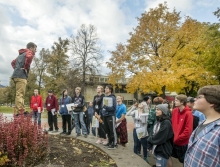Helping Prospective Students See Themselves on Campus
By Mary Krate, Inside Higher Ed I May 2 2022
MONTCLAIR, N.J. — Jennifer Burlage of Clinton was one of 18 students selected to participate in an episode of “The College Tour,” With some students not able to make it to campus for an in-person tour, colleges must ensure their virtual tours offer a clear sense of what the campus is like, says Mary Kreta of the University of Montana.

Coming off a decade of enrollment decline, it was clear that the University of Montana needed a new admissions strategy from top to bottom. While there was plenty of work to be done, one area we wanted to focus on was the university’s campus visit experience, including the virtual tour.
Between the pandemic and the many prospective students and parents in rural areas of Montana, we wanted remote visitors to be able to get a sense of the campus that highlighted its vibrancy, something they were not getting in the old virtual tour on our website.
According to a Student Voice survey conducted by Inside Higher Ed and College Pulse with support from Kaplan, a majority of students say virtual campus tours should include videos of residence halls, dining halls and classrooms, but many students who have taken virtual tours report not seeing these vital components of campus life. Another alarming statistic from the survey is that 55 percent of students also want virtual tours to include interaction with a student tour guide, but only 16 percent of students who took virtual tours reported having a one-on-one interaction with a student guide.
The survey also points out that students make their decisions to enroll based on academic programs and financial considerations. We know that our campus tour needs to highlight all aspects of being a student at UM.
Jeff Kallay, national campus visit expert and senior vice president of enrollment consulting at the higher ed firm Echo Delta, says, “The most important part of the virtual tour is what is most important to [students]: housing, food on campus, wellness and the facilities or academic interests. Ideally, a great virtual tour would survey each viewer and then offer up a personalized tour route based on what matters most to them.”
There was one more thing we wanted to take into consideration: 40 percent of our students are first generation, and over 7 percent are Native American, so making these tours equitable and valuable to all students was at the top of our list.
Revamping Our Tour
With all this information, we sat down to revamp our virtual tour by looking at the hierarchy of our students’ needs. We also partnered with The College Tour to provide another way for students to meaningfully connect with our campus from afar.
Our guiding light when creating the tour route, writing scripts and working with our student guides was the need to meet prospective students’ needs rather the impulse to show them what we wanted to highlight. A team of people in admissions and marketing built a student-focused tour and gathered feedback from our students throughout the process. Their unfiltered feedback on the script and on shooting locations led to numerous changes in the way we talked about our campus and how we highlighted our strengths.
Stephanie Geyer, UM’s director of digital strategy and innovation, recalls a student named “Zachariah Rides At The Door, [who] rewrote his script to start and end in his Blackfeet language, which made the segment much more compelling and authentic.” To date, this segment is also among the most viewed.
By coordinating these efforts and embedding some of the clips into our virtual tour, we created opportunities for engagement. We launched the tour in March 2022, and early numbers show higher-than-average visitor numbers and an inquiry rate of 14 percent.
Renewed Focus on In-Person Tours
While a large focus was on launching a high-quality virtual tour, we also revamped our on-campus tours and events, focusing on the overarching experience the students and their families have on our campus.
As the Student Voice survey points out, 56 percent of respondents visited campus in person, versus only 7 percent virtually. This high percentage of in-person visits is particularly exciting because it has helped to motivate robust conversations about how we personalize each visit and event.
Our newly implemented admitted-student event—Go Griz Days—celebrates our students’ accomplishments and facilitates new friendships through activities with other admitted and current students. The traditional focus on completing tasks necessary to register has moved online, because we want students to experience the components of campus life that truly drive their decision to enroll, not what the institution needs to get them to commit.
Students don’t want to hear from admissions officers; they want to hear from other students. They need to know about the academic program, but they also need to know about where they will eat and sleep.
Many of the first-generation student respondents to the Student Voice survey still made the trip to campus. This means we have a responsibility to ensure our campus visits speak directly to their accomplishments and concerns. It also tells us we need to rethink how we’re inviting first-generation students to interact with our virtual tours.
Campus visits in all forms are still foundational to the college search process, but we need to evolve. In an era when students can get a quality college degree online, we need to show them what they gain by coming to our campus. Students don’t want to hear from admissions officers; they want to hear from other students. They need to know about the academic program, but they also need to know about where they will eat and sleep. We are not simply transforming tours, we’re respecting students and working alongside them to help them see themselves as part of our campus community.
Bio
Mary Kreta is vice president for enrollment management and strategic initiatives at the University of Montana.
